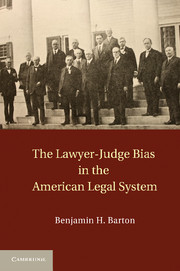Book contents
- Frontmatter
- Contents
- Acknowledgments
- 1 An Ambient Bias
- 2 The Theory
- 3 Constitutional Criminal Procedure
- 4 Civil Constitutional Law
- 5 A Short History of Lawyer Regulation
- 6 Current Lawyer Regulation
- 7 Torts
- 8 Evidence and Civil Procedure
- 9 The Business of Law
- 10 Enron's Sole Survivors
- 11 Complexity and the Lawyer–Judge Bias
- 12 Rays of Hope, Ramifications, and Possible Solutions
- Index
3 - Constitutional Criminal Procedure
Published online by Cambridge University Press: 03 May 2011
- Frontmatter
- Contents
- Acknowledgments
- 1 An Ambient Bias
- 2 The Theory
- 3 Constitutional Criminal Procedure
- 4 Civil Constitutional Law
- 5 A Short History of Lawyer Regulation
- 6 Current Lawyer Regulation
- 7 Torts
- 8 Evidence and Civil Procedure
- 9 The Business of Law
- 10 Enron's Sole Survivors
- 11 Complexity and the Lawyer–Judge Bias
- 12 Rays of Hope, Ramifications, and Possible Solutions
- Index
Summary
The right to be heard would be, in many cases, of little avail if it did not comprehend the right to be heard by counsel. Even the intelligent and educated layman has small and sometimes no skill in the science of law. … He requires the guiding hand of counsel at every step in the proceedings against him.
– Powell v. AlabamaThe Constitution says that everyone is entitled to an attorney of their choice. But the Constitution does not say that the lawyer has to be awake.
– Judge Doug ShaverTHE 1960S MARKED A DUE PROCESS REVOLUTION FOR criminal procedure, with the Supreme Court guaranteeing a set of rights to criminal defendants in both federal and state courts. Before the 1960s, the Court had applied many constitutional provisions in federal prosecutions, but not in state cases. In 1961, Mapp v. Ohio applied the exclusionary rule (which suppresses evidence that comes as a result of an unconstitutional search or seizure) to the states. In 1963, Gideon v. Wainwright extended the Sixth Amendment right to counsel to all indigent felony defendants. The Court extended the Fifth Amendment privilege against self-incrimination to the states in 1964, and it extended the Sixth Amendment right to confront and cross-examine witnesses to the states in 1965. The year 1966 brought perhaps the most famous case of them all, Miranda v. Arizona.
- Type
- Chapter
- Information
- The Lawyer-Judge Bias in the American Legal System , pp. 39 - 76Publisher: Cambridge University PressPrint publication year: 2010



